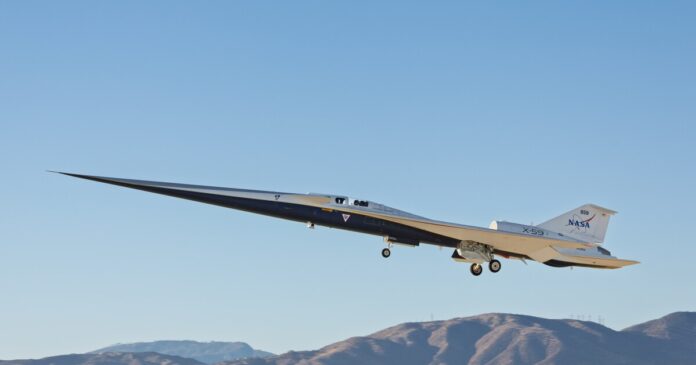NASA’s X-59 Quiet SuperSonic Technology (QueSST) experimental supersonic aircraft took to the skies for the first time on October 28, 2025 from Lockheed Martin’s famously secret Skunk Works at the US Air Force Plant 42 in Palmdale, California.
In the 1960s, civilian supersonic flight was seen as the future of the aerospace industry. In fact, there was so much confidence that national governments poured billions of dollars into a technological race that was comparable in scale to putting a man on the Moon. Small wonder that companies like British Aircraft Corporation were putting out publicity art showing the Anglo-French Concorde supersonic airliner in the livery of all the world’s major airlines in anticipation of hundreds of sales.
In the end, the age of supersonic passenger travel never materialized, with only 12 Concordes and two Tupolev Tu-144s entering regular passenger service, and the Tupolevs bowing out early after a string of technical issues. There were many reasons for the supersonic revolution ending before it began. Some were technical, others were financial, and some were political, but one of the biggest problems was the infamous sonic boom.
A sonic boom is caused by the shockwave that’s built up in front of an aircraft as it flies at supersonic speeds. Put simply, the air can’t get out of the way and it compresses into a cone-shaped wave. When this shock wave passes over a spot on the ground, it comes across as a loud boom of 110 dB to 140 dB, or equivalent to that of a thunderclap.
X-59
This boom was a problem in itself. It was not only annoying, but it disrupted livestock and wildlife, and could even break windows with its pressure wave. Worse, it provided ammunition to opponents to Concorde in the US who objected to it on environmental or nationalist grounds and who pushed for new regulations that were prejudicial against civilian supersonic flight.
Today, there are hopes of reviving supersonic travel on a large scale, with a number of companies across the world working on a new generation of Mach+ transports. To encourage this effort, NASA has been working with Lockheed Martin on the X-59, which is a technological demonstrator prototype designed to find ways to make 21st century supersonic flight feasible – and quieter.
The primary function of the single-seater X-59 is to test a new fuselage geometry that mitigates the sonic boom. It does this by shaping the flow of air from the nose and over the hull and wings so that instead of concentrating at the nose, the wave breaks up and spreads out along the aircraft, which also redirects the wave upwards. The result is that the sonic boom becomes a sonic thump of 60 dB to 80 dB, or about that of a car door closing for those on the ground.
This will not only help to make supersonic airliners play nice with others, it will also help to rewrite regulations. To that end, in future stages, the X-59 will fly over communities in a special supersonic air corridor to gather public opinion about the results.
The maiden flight that ended with a landing near NASA’s Armstrong Flight Research Center in Edwards, California only reached subsonic speeds because it was only intended to show the aircraft’s flightworthiness. In later tests, NASA plans to push the envelope until it goes past the speed of sound, after which the heavy work of the program can begin.
“We are thrilled to achieve the first flight of the X-59,” said OJ Sanchez, vice president and general manager of Lockheed Martin Skunk Works. “This aircraft is a testament to the innovation and expertise of our joint team, and we are proud to be at the forefront of quiet supersonic technology development.”
Source: Lockheed Martin


